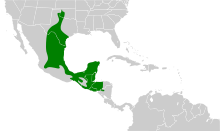Golden-fronted woodpecker
| Golden-fronted woodpecker | |
|---|---|

| |
| A male from the northern subspecies group at Roma, Texas | |
| Scientific classification | |
| Kingdom: | Animalia |
| Phylum: | Chordata |
| Class: | Aves |
| Order: | Piciformes |
| Family: | Picidae |
| Genus: | Melanerpes |
| Species: | M. aurifrons
|
| Binomial name | |
| Melanerpes aurifrons (Wagler, 1829)
| |

| |
The golden-fronted woodpecker (Melanerpes aurifrons) is a North American woodpecker. Its preferred habitat is mesquite, riparian woodlands, and tropical rainforest. It is distributed from Texas and Oklahoma in the United States through Mexico, Belize, Guatemala, El Salvador, Honduras and northern Nicaragua.[2] Cooke listed this species as an abundant resident of the lower Rio Grande Valley, Texas, in 1884.
Taxonomy[]
Recent genetic data indicate that the species as currently constructed is paraphyletic. The golden-fronted, golden-naped, wide-bar-backed birds from the north of the range ("true" golden-fronted woodpeckers) were shown to be more closely related to red-bellied woodpecker than the red-fronted, red-naped, narrow-bar-backed birds from the south. It is suggested that the latter population, the santacruzi group, be treated as a separate species, Velasquez's woodpecker. It is found from eastern Mexico to Nicaragua.[3]
Description[]
The plumage of the golden-fronted woodpecker is very similar in appearance to that of the Yucatan woodpecker (Melanerpes pygmaeus), which is also found throughout the Yucatán Peninsula. It can be very difficult to distinguish between these two species in the field. The golden-fronted woodpecker — which is much more common than the Yucatan woodpecker — has a larger body and a longer beak, and the female has more red on the nape of the neck than that of the Yucatan woodpecker. Importantly, the golden-fronted woodpecker has reddish feathers at the base of the bill, whereas the Yucatan Woodpecker has bright yellow feathers surrounding the base of the bill. The barring pattern on the back of the golden-fronted woodpecker is such that it has a blackish appearance from a distance, whereas that of the Yucatan woodpecker has a silvery appearance from a distance. Finally, the vocalization of the Yucatan woodpecker is also quite different from that of the golden-fronted woodpecker.[4][5][6]
Although the golden-fronted woodpecker is also very similar in appearance to the red-crowned woodpecker (Melanerpes rubricapillus), the distribution of these two species does not overlap.
Nesting[]
Nesting behavior of the golden-fronted is similar to that of the red-bellied woodpecker. Tall trees of pecan, oak, and mesquite are the major species used for nesting in the United States and northern Mexico. Occasionally fence posts, telephone poles, and bird boxes are used.
Diet[]
The diet of the golden-fronted woodpecker consists of both insects and vegetable matter. Grasshoppers make up more than half of the animal matter and other insects include beetles and ants. Vegetable matter consumed consists of corn, acorns, wild fruits, and berries.
Gallery[]

from the Mexican Boundary Survey

Male in flight, Texas

A "Velasquez's" golden-fronted woodpecker (M. a. dubius) from the Yucatán.

"Velasquez's" golden-fronted woodpecker preying on a scorpion in Belize
References[]
- ^ BirdLife International (2016). "Melanerpes aurifrons". IUCN Red List of Threatened Species. 2016: e.T22680862A92883010. doi:10.2305/IUCN.UK.2016-3.RLTS.T22680862A92883010.en. Retrieved 11 November 2021.
- ^ Husak, Michael S. and Terry C. Maxwell. (1998). Golden-fronted Woodpecker (Melanerpes aurifrons), The Birds of North America Online (A. Poole, Ed.). Ithaca: Cornell Lab of Ornithology; Retrieved from the Birds of North America Online: http://bna.birds.cornell.edu/bna/species/373 doi:10.2173/bna.373
- ^ García-Trejo, E. A.; De Los Monteros, A. E.; Arizmendi, M. D. C.; Navarro-Sigüenza, A. G. (2009). "Molecular Systematics of the Red-Bellied and Golden-Fronted Woodpeckers". The Condor. 111 (3): 442. doi:10.1525/cond.2009.080017. S2CID 84280533.
- ^ "Yucatán woodpecker: Melanerpes pygmaeus". eBird. Ithaca, New York: Cornell Lab of Ornithology. 2021. Retrieved 18 March 2021.
- ^ "Red-vented (Yucatan) Woodpecker: Centurus pygmaeus". Yucabirds.com. 2007. Retrieved 18 March 2021.
- ^ Gorman, Gerard (2014). "Yucatán woodpecker: Melanerpes pygmaeus". Woodpeckers of the World: The Complete Guide. Helm Photographic Guides. London: Bloomsbury Publishing. pp. 136–8. ISBN 978-1408147160.
- Agriculture Handbook No. 511. November 1977. Forest Service. U.S. Department of Agriculture. Virgil E. Scott, Denver Wildlife Research Center. Keith E. Evans, North Central Forest Experiment Station. David R. Patton, Rocky Mountain Forest and Range Experiment Station. Charles P. Stone, Denver Wildlife Research Center. Illustrated by Arthur Singer.
External links[]
| Wikimedia Commons has media related to Melanerpes aurifrons. |
- Golden-fronted woodpecker videos on the Internet Bird Collection
- Golden-fronted woodpecker, a bibliographic resource
- Golden-fronted woodpecker photo gallery at VIREO (Drexel University)
- IUCN Red List least concern species
- Melanerpes
- Native birds of the Plains-Midwest (United States)
- Birds of the Rio Grande valleys
- Birds of Mexico
- Birds of the Yucatán Peninsula
- Birds of Central America
- Birds described in 1829
- Taxa named by Johann Georg Wagler
- Birds of the Sierra Madre Oriental




